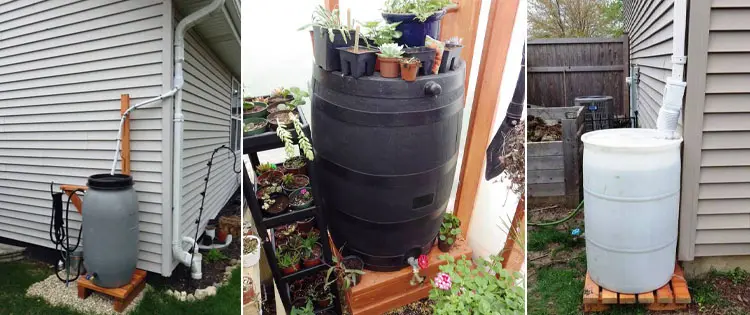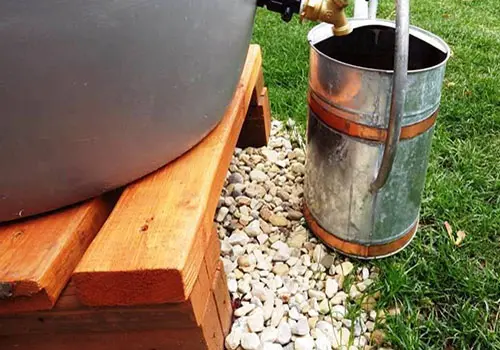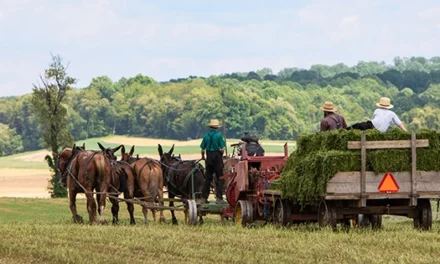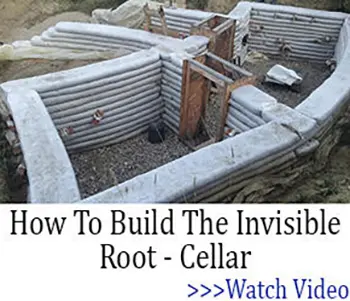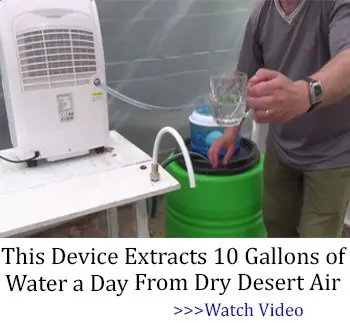I’ve been exploring rainwater harvesting systems, and they’re super easy to set up. They can lower your water bills and provide an emergency supply.
Most folks use 55-gallon barrels to collect rain from roofs through gutters and downspouts. You can find or make attachments with PVC pipe.
While rainwater is free and great for gardens, it can pick up dust and debris from roofs, so it’s not always pure. Simple filtration can help, but even clear rainwater can harbor bacteria. So if you plan to drink it, boil it for at least three minutes.
In this article, I’ll show you how I built my rainwater system and how you can too. It might seem simple to just let a downspout drain into a barrel. However, there are features that make these systems more efficient and user-friendly.
Here are the basics:
The Barrel
Most rain barrels come with a spigot at the bottom or front, making it easy to access the water. If you’re upcycling a barrel, you should add a spigot in that spot too.
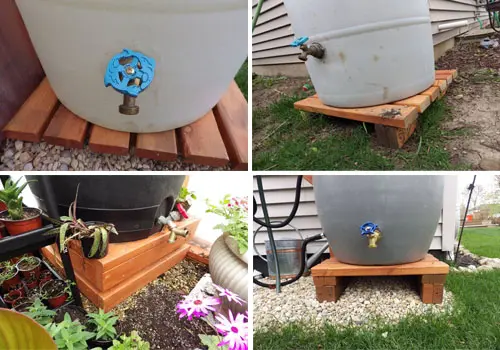
Rain barrels are available in different colors—like white, black, gray, and blue—and the color matters based on how you plan to use it.
Black barrels absorb heat from the sun, making them great for greenhouses since they radiate warmth at night. White barrels reflect heat and stay cooler, which is good for general outdoor use.
Gray barrels are neutral and blend in, while blue barrels help indicate that they’re for water. Most barrels also have an overflow spout near the top to manage excess water.
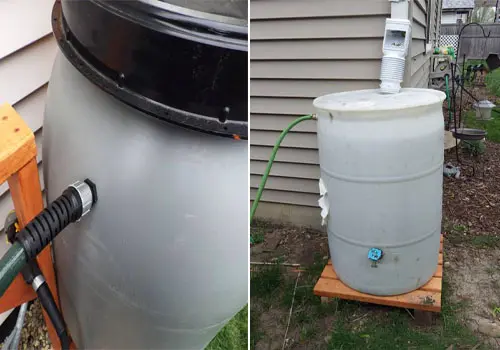
You can attach a hose to your rain barrel to direct water to a second barrel or to drain water away from buildings. Some folks even use soaker hoses at the end to automatically water their gardens with any runoff.
Another common feature of rain barrels is a built-in filter on the top.
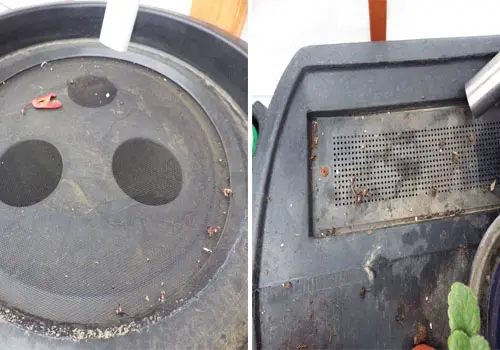
This collects leaves, sticks, debris, and other objects that have been carried to the barrel by the flow of the rainwater.
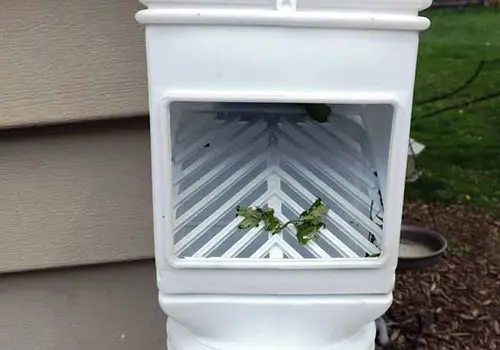
If upcycling a barrel from another use, there are filters that can be installed onto the downspout for the same purpose.
If you’re using an old barrel to collect rainwater, it’s important to know what was stored in it before. Many barrels have held chemicals that could be harmful to plants and people. The goal of collecting rainwater is to reuse it for something good, so using a contaminated barrel defeats that purpose.
DIY Ingenious Rainwater Harvesting Systems: Barrel Platform
Place your rain barrel on a platform if the ground is uneven. This also raises the spigot, making it easier to fit a watering can or bucket underneath.
Building a platform for your rain barrel is part of setting up rainwater harvesting systems. Use 4x4s for the base and 2x4s for the top. Measure and cut the pieces to fit the barrel’s bottom.
You might also want to add stones or bricks underneath for extra stability, but sometimes that’s all you need. Remember, a full 55-gallon rain barrel weighs over 400 pounds, nearly a quarter ton!
Rain Water Trapping and Funneling
There are special attachments for downspouts that collect rainwater and direct it to a hose leading to the barrel or straight to the barrel’s top filter, which are essential components of rainwater harvesting systems. You can find these at home improvement stores or online.
If needed, you can also direct rain into the barrel from a cut-down spot, but most of these attachments have filters to catch debris from the roof along with the rainwater. You can also make a funnel using a PVC reducer; just be sure to add a leaf trap to filter out any debris.
Related: How to Collect Rainwater Without Gutters
These reducers are used to connect larger PVC pipes to smaller ones. For example, a 4-inch to 2-inch reducer attached to a 2-inch PVC pipe, with the 4-inch side open, creates an instant funnel to capture rainwater from a gutter.
You can add more lengths of PVC to direct rain from other gutters, which can help increase the roof area you’re using for rainwater harvesting. Just go with what makes sense for your setup!
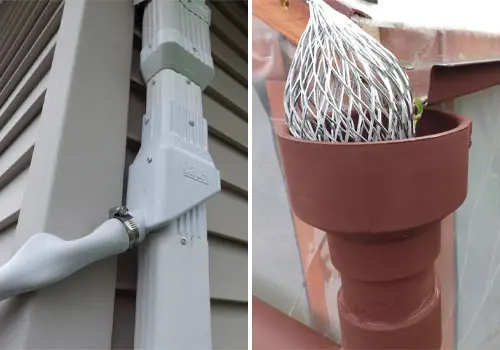
Rainwater Harvesting Systems: Installing Your Rain Barrel Collection System
Before setting up your rain barrel, there are a few things to consider. It’s important to choose the right spot because moving it later can be a hassle. Here are some key points to think about:
Location
When choosing a location for your rain barrel, there are two main things to consider: aesthetics and functionality. Aesthetically, most people prefer rain barrels to be out of sight, especially in front of the house. For outbuildings like greenhouses or sheds, appearance matters less, but it’s still good to think about whether the back of the house is a better spot.
When it comes to color, try to match the barrel to your home’s color scheme if you can, with neutral gray being a common choice.
Related: I Tried Drinking Water From My Stockpile and This Is What Happened
Functionally, place your rain barrel close to a downspout. While you can use a hose to move water around corners, being near the source is best.
Also, consider sunlight. A spot with southern exposure will get more sun and help the barrel capture and radiate heat—great for greenhouses. On the other hand, a northern exposure will keep the water cooler, which is better for drinking or watering plants. So, it all depends on how you plan to use the water!
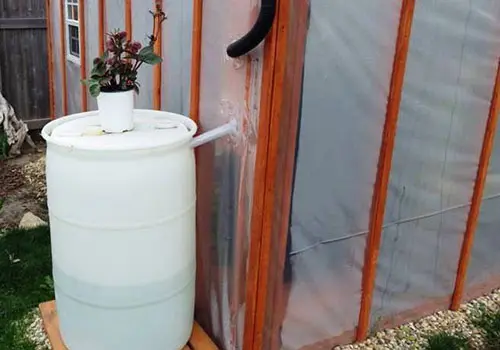
Downspout Channeling Installation
It’s tempting to set up your rain barrel as soon as you find a good spot, but first, you need to figure out how you’ll trap and channel the water into the barrel. This will help you determine the exact placement of the barrel, which could be just inches or feet away.
If your water trap or funnels are directly above the barrel, consider the height and location of any support or platform you’ll build, and measure the barrel’s height. This will help guide your downspout channel installation.
If the downspout channel directs water to the left or right with a hose attachment, install it first and see where the hose ends up. You want a clear path for the water to flow, ensuring the barrel is positioned for the best and most efficient collection.
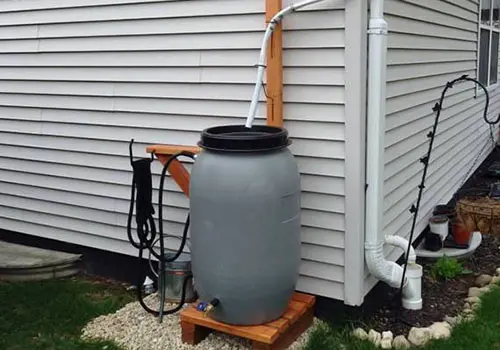
Build the Foundation or Platform
Once you’ve picked a spot for your rain barrel, it’s time to build a solid foundation to keep it level and support its weight. You can use bricks or stones, but a short platform will help elevate the spigot, making it easier to fill a watering can or bucket.
To determine the height of the spigot, measure the distance from the spigot on the bottom of the barrel to the barrel’s base. Then, measure your watering can’s height and add a few extra inches to ensure it fits under the spigot easily.
If you’re just attaching a hose for watering, the platform height isn’t as crucial. Just keep in mind that you won’t get the same water pressure as with a regular hose. Some water will flow through, but it might be more of a dribble than a steady stream like you’re used to from an outdoor faucet. This is where properly setting up your rainwater harvesting systems can make a big difference in water flow and overall efficiency.
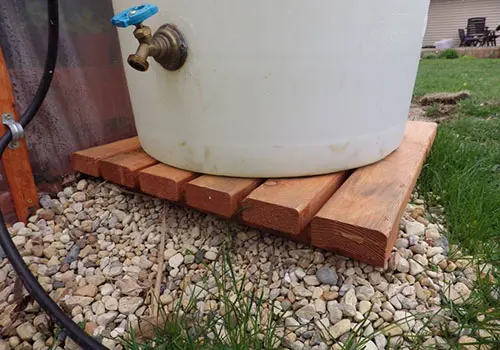
Install the Barrel
Once your foundation or platform is ready, place the barrel on top, making sure the top screen is positioned directly under the water outlet.
Turn off the spigot, and then attach a hose to the overflow at the top of the barrel. This will allow any excess water to either drain on the ground or fill another barrel, enhancing your rainwater harvesting systems for better water management.
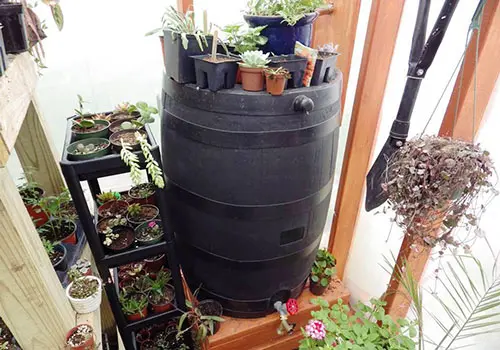
Ingenious Rainwater Harvesting Systems: Use the Water
It’s great to watch your barrel fill up, but eventually, you’ll need to use some of that water. If you’re using a watering can, having two can be helpful.
This way, you can let one fill while you use the other. It can be frustrating to wait for a watering can to fill, especially when you’re getting low on water. That’s when the pressure is steady but the flow slows down.
As you gain experience using your harvested rainwater, you might consider adding another barrel connected to the overflow valve as part of your rainwater harvesting systems. With any luck, you’ll cut down on your water bill and always have some water available in an emergency.
Read This Before Harvesting Rainwater
The Water You Need in a Crisis and How to Preserve It (Video)
States That Will Punish You for Harvesting Rainwater. Do You Live In One Of Them?

